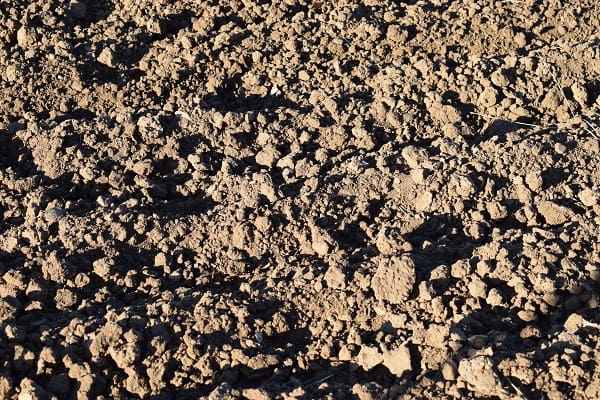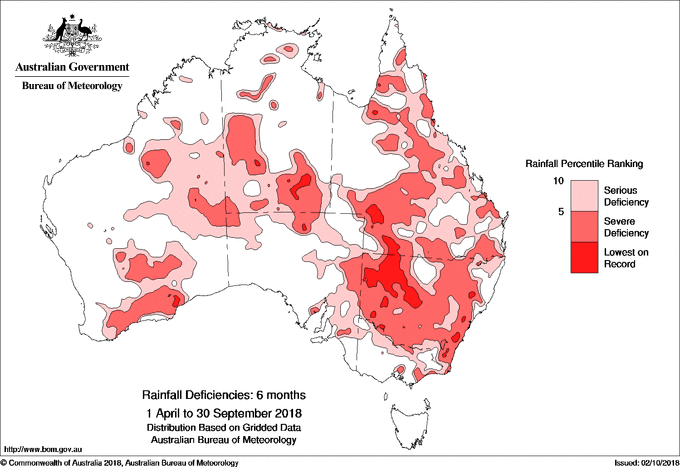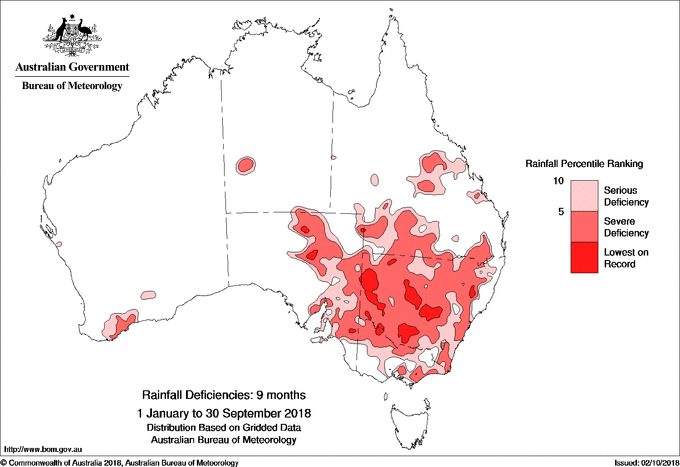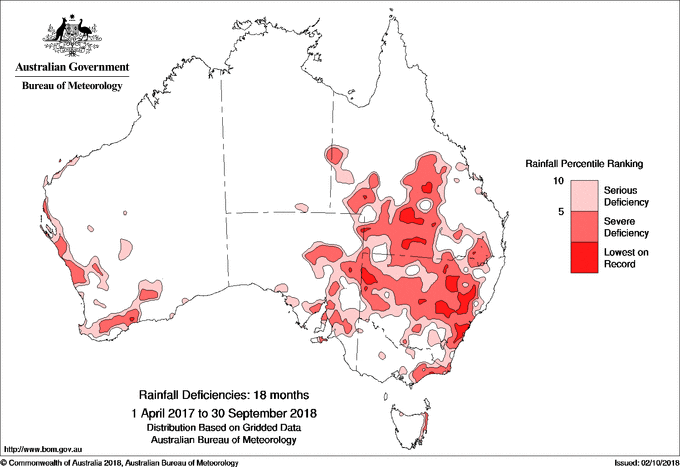SEPTEMBER rainfall was below average across the majority of Australia, and especially so across the southern mainland, according to the latest drought statement from the Bureau of Meteorology.
It was the driest September on record nationally, and the second driest September on record for Victoria, third driest for Western Australia, and fourth driest for South Australia.
Rainfall totals were in the lowest 10 per cent of historical rainfall totals for the month in large areas including greater southwestern WA (southwest of a line between about Geraldton and Esperance), SA from Ceduna east across the Eyre Peninsula and agricultural districts, much of the western half of New South Wales, and nearly all of Victoria except parts of South and West Gippsland.
Total rainfall for the month was the lowest on record for September at many sites in Victoria and WA, and a handful of locations in NSW and Tasmania.
The year to date has also been exceptionally dry over the mainland southeast, with significant rainfall deficiencies continuing to affect large areas of eastern Australia at timescales out to around two years duration.
Compared to other January to September periods since 1900, year-to-date rainfall has been the second lowest on record for the Murray–Darling Basin, third lowest for NSW, and eighth lowest for Victoria.
Deficiencies have increased in both extent and severity at each of the six-, nine- and 18-month timescales across eastern Australia and parts of WA.
Deficiencies have increased for much of NSW, with the area of severe deficiencies now extending further into eastern and northern Victoria, eastern SA, inland southern Queensland, and south coast WA than compared to periods ending August 2018.
Accompanying recent low rainfall have been unusually high day-time temperatures, which add to the impact of reduced rainfall (e.g. as seen through reduced soil moisture).
Australian maximum temperatures for 2018 to date have been the second warmest on record with an anomaly of +1.36 °C (behind 2013 with an anomaly of +1.54 °C).
Both NSW (+2.17 °C) and the Murray–Darling Basin (+2.10 °C) have experienced their warmest January–September period on record.
……………………………………
Figure 1: Six-month rainfall deficiencies
THE southern rainfall season spans April to November and corresponds to the southern agricultural cropping season. For 2018, the southern rainfall season to date has so far seen 6 consecutive months of below average rainfall across much of Australia. Serious or severe rainfall deficiencies persist across much of the eastern mainland, affecting northern and eastern Victoria, nearly all of NSW except along the northern coast and a pocket of the central inland north, large areas of Queensland apart from the inland north west to Gulf Coast region, and eastern SA between about Adelaide and the NSW/Queensland border. A large area of north western NSW, and smaller pockets in the south west NSW and along the ranges in the east of the State, and in south western Queensland, have received lowest on record total rainfall for the six months April to September 2018.
Large areas of serious or severe rainfall deficiencies are also in place for Central Australia and WA’s Interior District, and across an area along the south coast of WA and much of the southern Goldfields District.
Compared to the five-month period ending August 2018, deficiencies have increased in severity across southern WA, eastern SA, northern and eastern Victoria, and much of the affected areas of NSW and Queensland, particularly in western NSW and southern Queensland.
………………………………………
Figure 2: Nine-month rainfall deficiencies
FOR the year to date, deficiencies have increased in severity across south eastern Australia to southern Queensland, and on the south coast of WA. The area affected by deficiencies has expanded between Albany and Hopetoun in WA, and in central southern Victoria. Across the east of SA (but excluding the far south east), northern and eastern Victoria, NSW (excluding the northern coast), inland southern Queensland, and a pocket of Queensland, and a pocket of Queensland adjacent to and inland of Mackay serious or severe deficiencies persist, and have generally increased in strength.
………………………………………..
Figure 3: 18-month rainfall deficiencies
SIMILAR to deficiencies for other monitored periods in this drought statement, rainfall deficiencies have increased across nearly all affected areas for the 18 months commencing April 2017, although changes in absolute severity are smaller than for shorter periods due to the larger total accumulated rainfall deficits over the longer period.
Serious or severe rainfall deficiencies are in place across most of NSW except the north east and parts of the southern border country, across eastern to central southern Victoria, much of southern, central inland, and southwestern Queensland, much of eastern SA except the far south east, and along parts of the west and south coast of WA.
Compared to the 17-month period ending August 2018, the area affected by deficiencies has increased in south coast WA, now reaching to Busselton and inland towards Kalgoorlie, across the northern Eyre Peninsula and Murraylands and Riverland districts of SA, across southern NSW, and in central southern Victoria.
Source: BOM







HAVE YOUR SAY